How to Choose a Life Jacket for Kayaking and Canoeing
May 15, 2023

Selecting a properly fitting life jacket or personal flotation device for kayaking or canoeing is crucial for any time spent on the water. Although it may not be necessary in all situations, keeping one on hand is essential to ensure your safety and readiness on the rare occasion when something goes awry. Which paddling life jacket you choose depends primarily on your specific activities and personal comfort.
What is a life jacket?
A life jacket, or personal flotation device (PFD), is designed to keep the wearer's head above water and ensure safety in various water-related activities, especially kayaking, canoeing, and other forms of boating.
Do I have to wear a life jacket when kayaking?
It is mandatory by law to wear a life jacket when operating a kayak, canoe, stand-up paddleboard, or any similar small watercraft. And to ensure your safety, it’s essential to choose a well-fitted and comfortable life jacket.

Life jackets are one of the most essential accessories for kayaking, but how do you determine the appropriate life jacket for your needs? Read the article from our partner, champion kayaker, and host of PaddleTV, Ken Whiting, where you will discover:
- The Types of Lifejackets: learn the difference between Type 1, 2, and 3.
- Inflatable vs Standard Life Jackets
- How to Choose the Right Life Jacket for You
- What Other Features Should You Consider?
Or watch the video below:
Psst, there's an Outdoorplay discount code in the video.
Types of Life Jackets
There are five (5) types of life jackets, each intended for different uses & persons. Here’s a quick explanation of each:
-
Type I – designed for rough or remote waters, where help might be hours away should it be required. They're bulky but incredibly buoyant; if the wearer becomes unconscious, the PFD will turn them face up. For reference, the orange vests used by commercial vessels are often type I. These jackets can come in buoyant, inflatable, or hybrid styles, depending on the model.
-
Type II – built for calm, inland waters where rescue isn’t too far away. They’re less bulky and more affordable than Type I but are considered less comfortable than Type III. These PFDs can turn some unconscious individuals face up, though this isn’t their primary intention.
-
Type III – made for paddlers in areas with quick rescue possibilities, enabling the wearer to comfortably wear it for long periods and swim or paddle without much resistance. In certain situations, these may turn wearers face up.
-
Type IV – these throwable flotation aids are for conscious individuals in distress, serving as supplemental safety gear alongside life jackets or PFDs. They include life rings and buoyant cushions but are not designed for wear nor required for use with canoes, kayaks, or SUPs.
- Type V - specially designed for specific activities, requiring wear during those activities to comply with United States Coast Guard (USCG) standards. They're designed for kayaking, waterskiing, and windsurfing and are available in inflatable or hybrid forms. These PFDs must be worn as instructed on their label for legal acceptance.
Inflatable vs Standard Life Jackets
Inflatable life jackets offer a sleek, less encumbering fit ideal for comfort and ease of movement, suited to calm waters and swimmers & paddlers confident in their abilities. They require manual inflation and regular maintenance. On the other hand, standard life jackets are made from foam and provide immediate buoyancy without the need for activation, making them safer for rapid rescue situations, non-swimmers, or rough water conditions. They are bulkier but safer for inexperienced paddlers or those in extreme water or rapid conditions.
Things to Consider When Choosing the Best Life Jacket for Kayaking & Canoeing
Life Jacket Sizing
Specific to kayaking & canoeing, a well-fitting PFD should enable you to adjust the jacket to accommodate your body shape & size and feature secure straps to keep the jacket in place during activity and in the water. Paddling-specific life jackets are designed without crotch straps, allowing you to move around without discomfort and helping you paddle efficiently. Also, if you’re wearing extra layering while kayaking, like a wetsuit, drysuit, or thermals, you must account for the additional size.
Choosing the Right Type
The type of kayaking or canoeing you plan to engage in dramatically determines the jacket you’ll need. Mesh-back jackets cater to high-back recreational seats, keeping you comfortable as you lean back without sacrificing safety. For kayaks with lower back support, standard jackets are more than acceptable. Meanwhile, thin-back jackets offer versatility across different kayak designs. If you’re involved in rescue activities, choose a vest with a quick-release harness.
Women & Children’s Jackets
Special consideration should be given to life jackets designed for women and children. Women's life jackets are tailored for a better fit and comfort, while children's life jackets must be correctly sized to ensure they don't ride up and slip over their heads.
Special Features
Preferences will vary between individuals, especially those who engage in different activities, like kayaking vs. fishing. In any case, there are particular features that you should look for when shopping for your next kayaking life jacket. Look for PFDs with multiple adjustment straps for a secure fit, large armholes for better paddling mobility, and reflective strips for increased visibility.
For fishers & sea tourers especially, pockets and attachment points for gear and safety equipment can make all the difference. Some jackets offer ventilation for cooling, while others provide additional warmth over top of your wetsuit or drysuit, a significant comfort factor in cold conditions.

